The Use of Wavelet Analysis to Improve the Accuracy of Pavement Layer Thickness Estimation Based on Amplitudes of Electromagnetic Waves
Abstract
1. Introduction
2. Pavement Layers Thickness Estimation Based on GPR Method
2.1. Thickness Estimation Based on GPR Method
| layer thickness | |
| speed of light propagation in a vacuum, | |
| two-way travel time between reflections from boundary surfaces | |
| dielectric constant of the layer. |
2.2. Dielectric Constant of Hot Mix Asphalt (HMA) Published in Literature
2.3. Calculation of Dielectric Constants Based on the Amplitude of the Wave Reflected from the Surface
| dielectric constant of the first layer of the medium | |
| reflected wave amplitude on the border: air-tested surface | |
| reflected wave amplitude on the border: air-metal plate (reference amplitude). |
2.4. Impact of Incorrect Estimation of the Dielectric Constant on the Accuracy of Asphalt Pavement Thickness Determination
| relative error in thickness determination using the GPR method | |
| layer thickness determined by the GPR method | |
| reference thickness of the layer (thickness of the drilled core). |
3. Wavelet Analysis of GPR Signal
3.1. Theoretical Foundations of Wavelet Analysis
3.2. The Use of Wavelet Analysis in GPR Signal Interpretation
4. GPR Measurements of Asphalt Slabs in Various Atmospheric Conditions
4.1. Testing Area
4.2. A-Scans from m1–m5 Slabs Measurements in Various Atmospheric Conditions
4.3. Dielectric Constants of HMA
4.3.1. Dielectric Constants Calculated based on Propagation Time through the Slab of Known Thickness, Hereinafter Named the “B” Method
4.3.2. Dielectric Constants Calculated based on the Amplitude of the Wave Reflected from the Surface, Hereinafter Named the “A” Method
4.3.3. Calculated Slabs Thicknesses Based on the Wave Amplitude Reflected from the Surface
4.3.4. Correction Coefficients for Dielectric Constants Determined based on the Amplitudes Reflected from the Surface
| correction coefficients for dielectric constants determined based on the amplitudes | |
| dielectric constants calculated based on propagation time through the slabs (“B” method) | |
| dielectric constants calculated based on the amplitudes (“A” method). |
4.4. Wavelet Analysis of the GPR Signal
5. Discussion
6. Conclusions
- The value of dielectric constant that is necessary to determine the layer thickness based on the GPR method can be determined either based on the thickness of the cores (“B” method) or based on the amplitude of the wave reflected from the surface (“A” method). The “B” method is accurate, and a possibility of coring is usually limited; therefore, this method can be used for testing a homogeneous section in terms of the layer’s material. The “A” method allows recognizing the thickness over a large distance without drilling. Its accuracy depends on the surface conditions that result from atmospheric conditions that are present during the test, and they require a proper correction of dielectric constant.
- The value of the dielectric constant was calculated based on the amplitudes estimated in different atmospheric conditions: (changes in the temperature, moisture, presence of ice/snow, presence of de-icing salt). In the conducted test, the error of thickness measurement was:
- (a)
- up to 11% when measuring in negative ambient temperature
- (b)
- up to 11% during measurements of the asphalt’s slab surface covered with water film
- (c)
- up to 8% during measurements of the ice-covered asphalt’s slab surface
- (d)
- up to 16% when measuring asphalt slab with a surface covered with a thin layer of fresh snow
- (e)
- even 29% during measurements of asphalt slab with a surface covered with a layer of de-icing salt
- The purpose of this work was to improve the accuracy of determining the thickness of layers based on dielectric constants calculated based on the wave amplitudes reflected from the surface. It was proposed to achieve it using wavelet analysis and based on the wavelet scalogram to determine the effect of surface conditions during the measurements. Then, the correction factor for the dielectric constant was calculated based on the amplitude of the wave reflected from the surface, and the thickness was calculated based on the corrected dielectric constant value. After applying correction factors for dielectric constants, the error in determining the thickness was reduced (especially the error in measuring the thickness of the surface covered with de-icing salt). The average thickness determination errors were reduced:
- (a)
- when measuring in negative ambient temperature, to on average 4%
- (b)
- when measuring the asphalt’s slab surface covered with water film, to on average 5%
- (c)
- when measuring the ice-covered asphalt’s slab surface to on average 4%
- (d)
- when measuring the asphalt slab with surface covered with a thin layer of fresh snow, to on average 6%
- (e)
- when measuring the asphalt slab with a surface covered with a layer of de-icing salt, to on average 4%
It should be noted that the correction coefficients have been calculated as the average of the coefficients for 5 slabs with different HMA wearing courses for specific atmospheric conditions. To significantly reduce the error, a dielectric constant correction factor calculated for a specific HMA wearing course should be applied. - The usefulness of wavelet analysis for determining the presence of de-icing salt on the tested surface has been demonstrated—its presence is clearly visible on the wavelet scalogram. This is particularly useful, because the salt significantly affects the value of the dielectric constant and causes a thickness measurement error 21% (in average)—and it is not possible to recognize the presence of de-icing salt on the surface neither based on the visual assessment of the surface, nor based on basic radargram analysis. No significant changes were observed on the wavelet scalograms from the signal recorded in the different surface conditions.
- Until the time of satisfactory development of the correction coefficients for dielectric constants, it is recommended to use the hybrid method for determining the thickness of layers using the GPR method—calculating the dielectric constant based on the amplitude of the wave reflected from the surface and each time determining the correction coefficient due to the surface condition based on drilled cores. In addition, selective wavelet analysis is recommended for the possible detection of the presence of de-icing salt when measurements are taken in the autumn and winter.
Author Contributions
Funding
Acknowledgments
Conflicts of Interest
References
- Yi, L.; Zou, L.; Sato, M. Practical Approach for High-Resolution Airport Pavement Inspection with the Yakumo Multistatic Array Ground-Penetrating Radar System. Sensors 2018, 18, 2684. [Google Scholar] [CrossRef] [PubMed]
- Miechowski, T.; Sudyka, J.; Harasim, P.; Kowalski, A.; Kusiak, J.; Borucki, R.; Grączewski, A. Impact of Accuracy of Pavement Structure Identification on Road Reparation Projects, Research work of the Road and Bridge Research Institute (IBDiM). 2006; pp. 1–76, (In Polish). Available online: https://www.gddkia.gov.pl/userfiles/articles/p/prace-naukowo-badawcze-zrealizow_3435//documents/wplyw-dokladnosci.pdf (accessed on 31 March 2020).
- Uniwersał, P. The impact of selected factors on the measured deflections and on the results of the identification of stiffness modules using the FWD (In Polish). Nowocz. Bud. Inż. 2016, 6, 62–65. [Google Scholar]
- Benedetto, A.; Pajewski, L. Civil Engineering Applications of Ground Penetrating Radar; Springer Transactions in Civil and Environmental Engineering: Rome, Italy, 2015; ISBN 978-3-319-04812-3. [Google Scholar]
- Lalagüe, A. Use of Ground Penetrating Radar for Transportation Infrastructure Maintenance. Ph.D. Thesis, Norwegian University of Science and Technology, Trondheim, Norway, June 2015. [Google Scholar]
- Li, W.; Wen, J.; Xiao, Z.; Xu, S. Application of Ground-Penetrating Radar for Detecting Internal Anomalies in Tree Trunks with Irregular Contours. Sensors 2018, 18, 649. [Google Scholar] [CrossRef] [PubMed]
- Hamrouche, R.; Saarenketo, T. Improvement of coreless method to calculate the average dielectric value of the whole asphalt layer of a road pavement. In Proceedings of the 15th International Conference on Ground Penetrating Radar, Brussels, Belgium, 30 June–4 July 2014; pp. 1–4. [Google Scholar]
- Al-Qadi, I.L.; Lahouar, S.; Loulizi, A. Successful application of GPR for quality assurance/quality control of new pavements, [w:] transportation research record journal of the transportation research board. In Proceedings of the 82th Annual Meeting, Washington, DC, USA, 12–16 January 2003; pp. 1–24. [Google Scholar]
- Zhang, J.; Ye, S.; Yi, L.; Lin, Y.; Liu, H.; Fang, G. A Hybrid Method Applied to Improve the Efficiency of Full-Waveform Inversion for Pavement Characterization. Sensors 2018, 18, 2916. [Google Scholar] [CrossRef] [PubMed]
- Surface Testing Instruments. Available online: https://www.elektrophysik.com/pl/produkty/pomiar-grubosci-jezdni/stratotest-4100 (accessed on 18 February 2020).
- Hoła, J.; Bień, J.; Schabowicz, K. Non-destructive and semi-destructive diagnostics of concrete structures in assessment of their durability, Bulletin of the Polish Academy of Sciences. Tech. Sci. 2015, 63, 87–96. [Google Scholar]
- Adamczewski, G.; Garbacz, A.; Piotrowski, T.; Załęgowski, K. Application of combined NDT methods for assessment of concrete structures (In Polish). Mater. Bud. 2013, 9, 2–5. [Google Scholar]
- Schabowicz, K.; Jawor, D.; Radzik, Ł. Analysis of non-destructive acoustic methods for testing renovated concrete structures (In Polish). Mater. Bud. 2015, 11, 103–105. [Google Scholar]
- U.S. Department of Transportation, Federal Highway Administration. Available online: https://fhwaapps.fhwa.dot.gov (accessed on 18 February 2020).
- Hoegh, K.; Khazanovich, L.; Yu, T.H. Ultrasonic Tomography for Evaluation of Concrete Pavement. Transp. Res. Board 2011, 2232, 85–94. [Google Scholar] [CrossRef]
- Schabowicz, K. Non-Destructive Testing of Materials in Civil Engineering. Materials 2019, 12, 3237. [Google Scholar] [CrossRef] [PubMed]
- Daniels, D.J. Ground Penetrating Radar, 2nd ed.; The Institution of Electrical Engineers: London, UK, 2004; pp. 1–761. ISBN 0-86341-360-9. [Google Scholar]
- D4748-10 Standard Test Method for Determining the Thickness of Bound Pavement Layers Using Short-Pulse Radar; ASTM International: West Conshohocken, PA, USA, 2012; pp. 1–7.
- DMRB Design Manual for Roads and Bridges, HD 29/08 Data for Pavement Assessment: Ground Penetrating Radar for Pavement Assessment, Part 2, Volume 7, Chapter 6, Section 3; Highways Agency: London, UK, 2008; pp. 1–94.
- Saaranketo, T. Electrical Properties of Road Materials and Subgrade Soils and the Use of Ground Penetrating Radar in Traffic Infrastructure Surveys. Ph.D. Thesis, Faculty of Science of the University of Oulu, Oulu, Finland, November 2006; pp. 1–127. [Google Scholar]
- Karczewski, J.; Ortyl, Ł.; Pasternak, M. Outline of the GPR Method (In Polish), 2nd ed.; AGH Publishing: Kraków, Poland, 2011; pp. 1–345. ISBN 978-83-7464-422-8. [Google Scholar]
- Willet, D.A.; Rister, B. Ground Penetrating Radar—Pavement Layer Thickness Evaluation; Kentucky Transportation Center: Lexington, Kentucky, 2002; pp. 1–36. Available online: https://uknowledge.uky.edu/cgi/viewcontent.cgi?article=1249&context=ktc_researchreports (accessed on 31 March 2020).
- Al-Qadi, I.L.; Lahouar, S.; Loulizi, A. Ground-Penetrating Radar Calibration at the Virginia Smart Road and Signal Analysis to Improve Prediction of Flexible Pavement Layer Thicknesses; Virginia Tech Transportation Institute: Blacksburg, Virginia, 2005; pp. 1–66. Available online: https://vtechworks.lib.vt.edu/bitstream/handle/10919/46647/05-cr7.pdf?sequence=1&isAllowed=y (accessed on 31 March 2020).
- Wutke, M.; Lejzerowicz, A.; Jackiewicz-Rek, W.; Garbacz, A. Influence of variability of water content in different states on electromagnetic waves parameters affecting accuracy of GPR measurements of asphalt and concrete pavements. In Proceedings of the 64 Scientific Conference of the Committee for Civil Engineering of the Polish Academy of Sciences and the Science Committee of the Polish Association of Civil Engineers (PZITB) (KRYNICA 2018), Krynica, Poland, 16–20 September 2018; Volume 262, pp. 1–9. [Google Scholar]
- Iyengar, B. A Textbook of Engineering Mathematics; Laxmi Publications: New Delhi, India, 2004; p. 1425. ISBN 10: 8170083656. [Google Scholar]
- Wavelet Transform (In Polish), Lectures at the AGH University of Science and Technology. Available online: http://home.agh.edu.pl/~jsw/oso/FT.pdf (accessed on 15 June 2017).
- Batko, W.; Mikulski, A. Wavelet transform in the diagnosis of hoisting devices. Diagnostyka 2004, 30, 61–68. (In Polish) [Google Scholar]
- Adamczak-Bugno, A.; Świt, G.; Krampikowska, A. Assessment of destruction processes in fibre-cement composites using the acoustic emission method and wavelet analysis. Mater. Sci. Eng. 2019, 471, 1–10. [Google Scholar] [CrossRef]
- Rucka, M.; Wilde, K. Application of continuous wavelet transform in vibration based damage detection method for beams and plates. J. Sound Vib. 2006, 297, 536–550. [Google Scholar] [CrossRef]
- Garbacz, A.; Piotrowski, T.; Courard, L.; Kwaśniewski, L. On the evaluation of interface quality in concrete repair system by means of impact-echo signal analysis. Constr. Build. Mater. 2017, 134, 311–323. [Google Scholar] [CrossRef]
- Zhang, S.; Li, Y.; Fu, G.; He, W.; Hu, D.; Cai, X. Wavelet Packet Analysis of Ground–Penetrating Radar Simulated Signal for Tunnel Cavity Fillings. J. Eng. Sci. Technol. 2018, 11, 62–69. [Google Scholar] [CrossRef]
- Shangguan, P.; Al-Quadi, I.L.; Leng, Z. Development of Wavelet Technique to Interpret Ground-Penetrating Radar Data for Quantifying Railroad Ballast Conditions. J. Transp. Res. Board Natl. Acad. 2012, 2289, 95–102. [Google Scholar] [CrossRef]
- Javadi, M.; Ghasemzadeh, H. Wavelet analysis for ground penetrating radar applications: A case study. J. Geophys. Eng. 2017, 14, 1189–1202. [Google Scholar] [CrossRef]
- Baili, J.; Lahouar, S.; Hergli, M.; Al-Qadi, I.L.; Besbes, K. GPR signal de-noising by discrete wavelet transform. NDT E Int. 2009, 42, 696–703. [Google Scholar] [CrossRef]
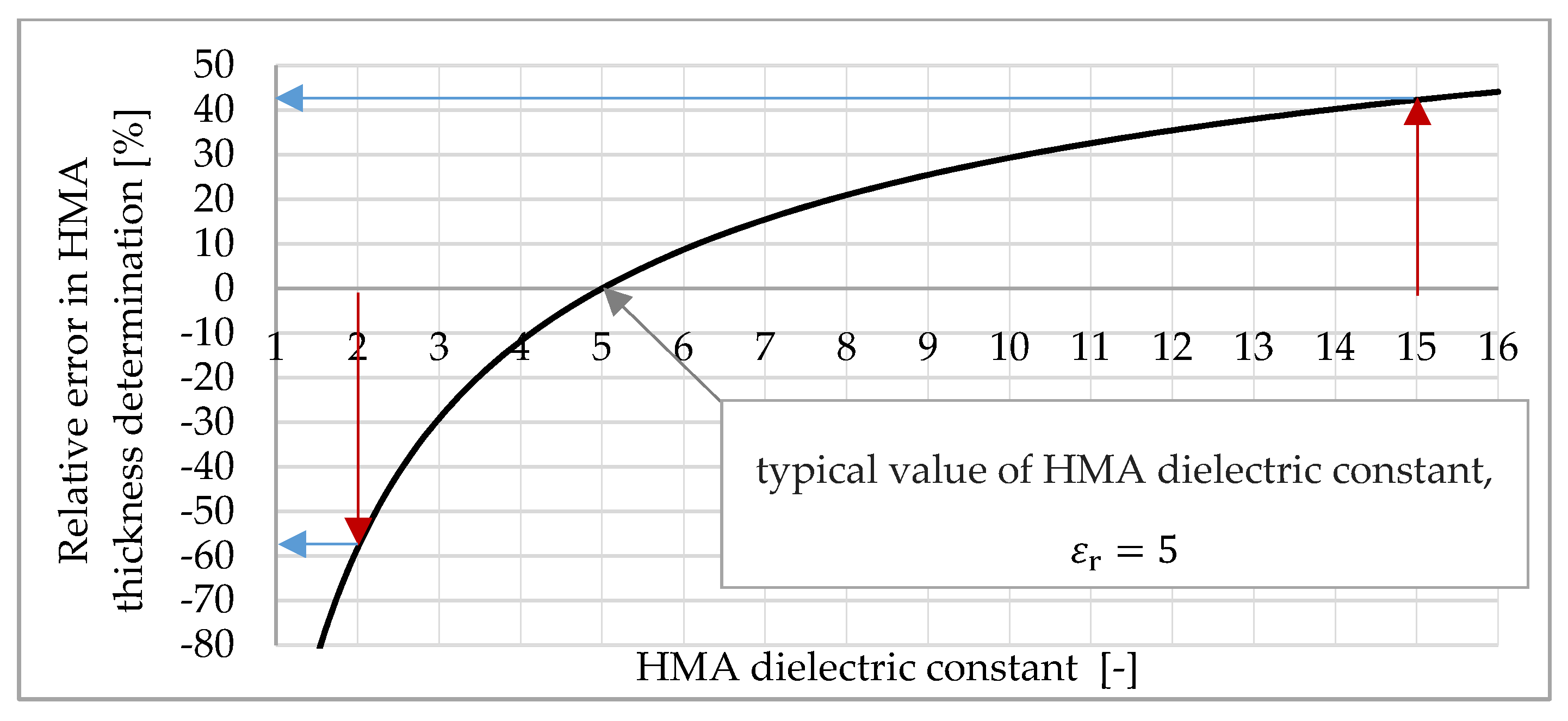
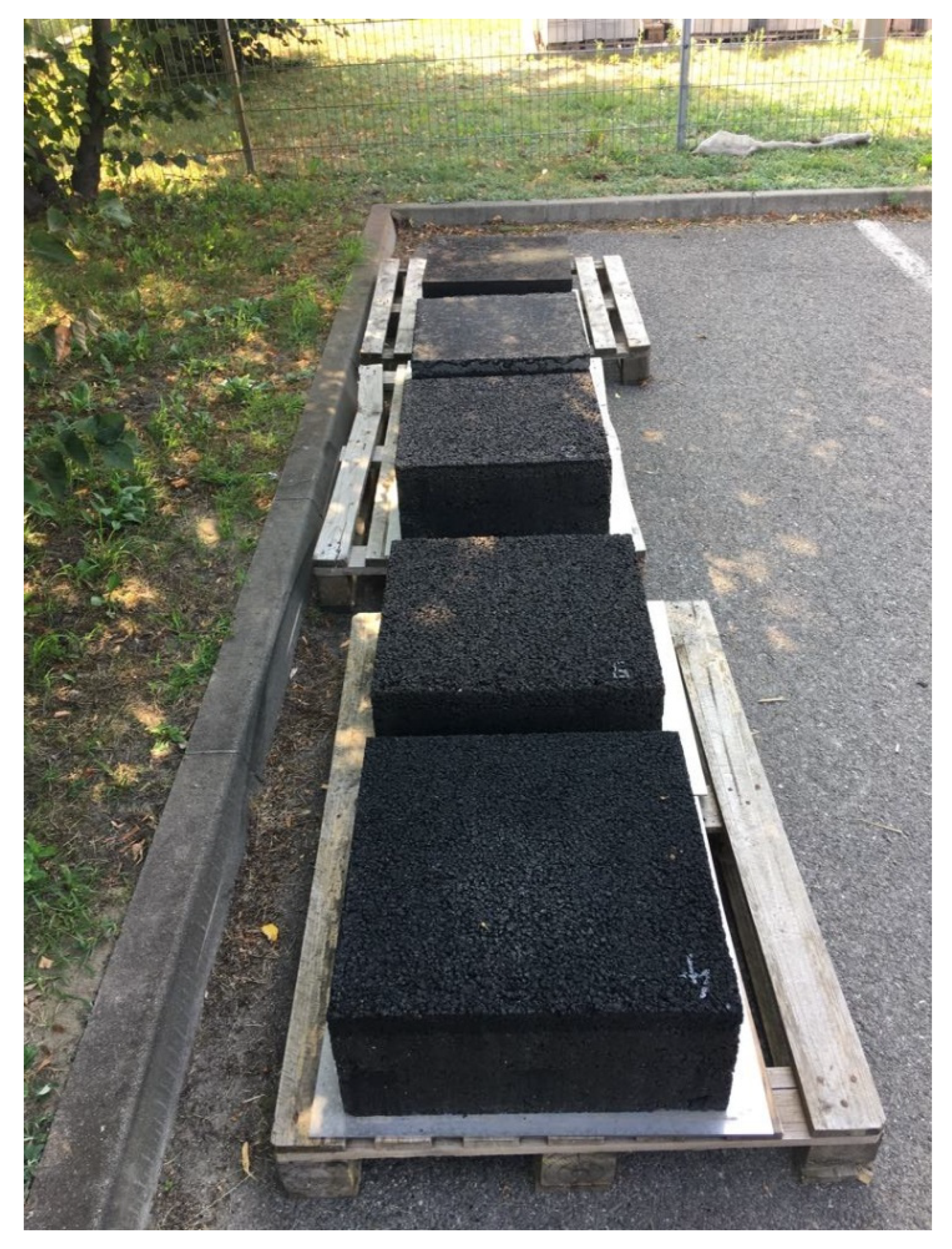
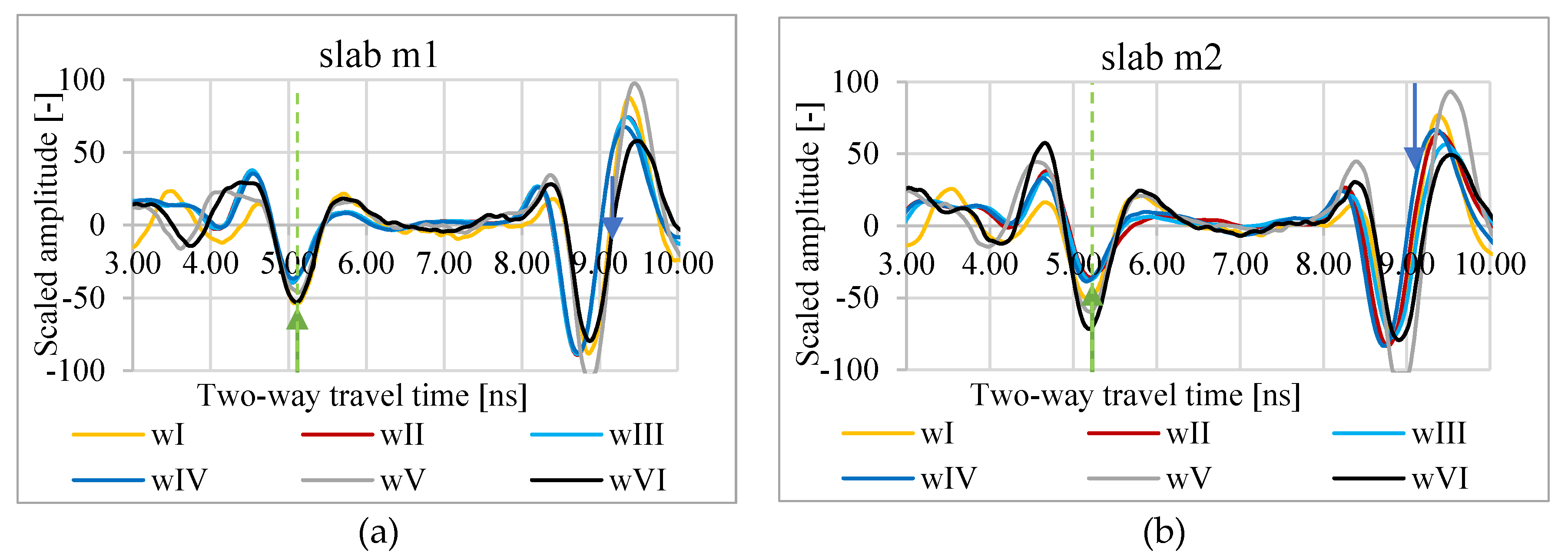
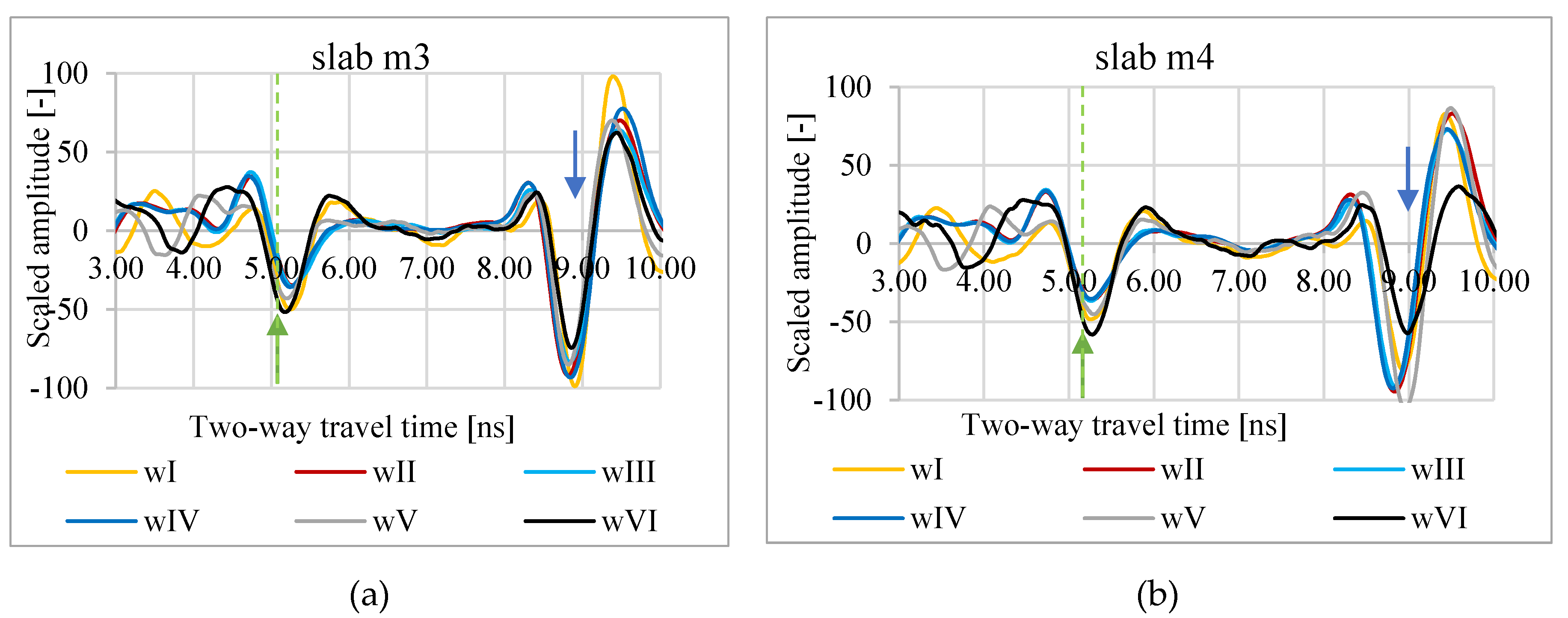
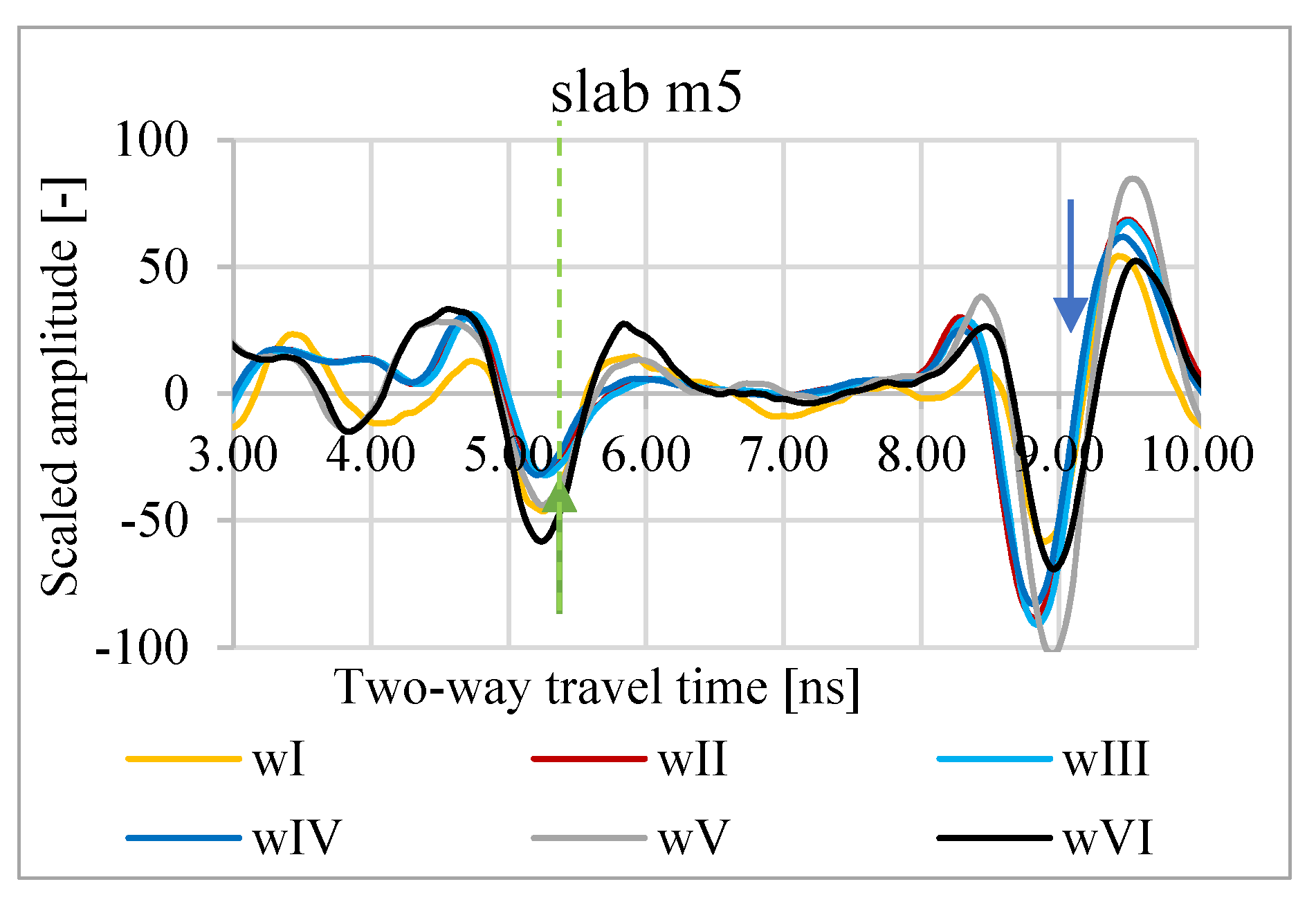
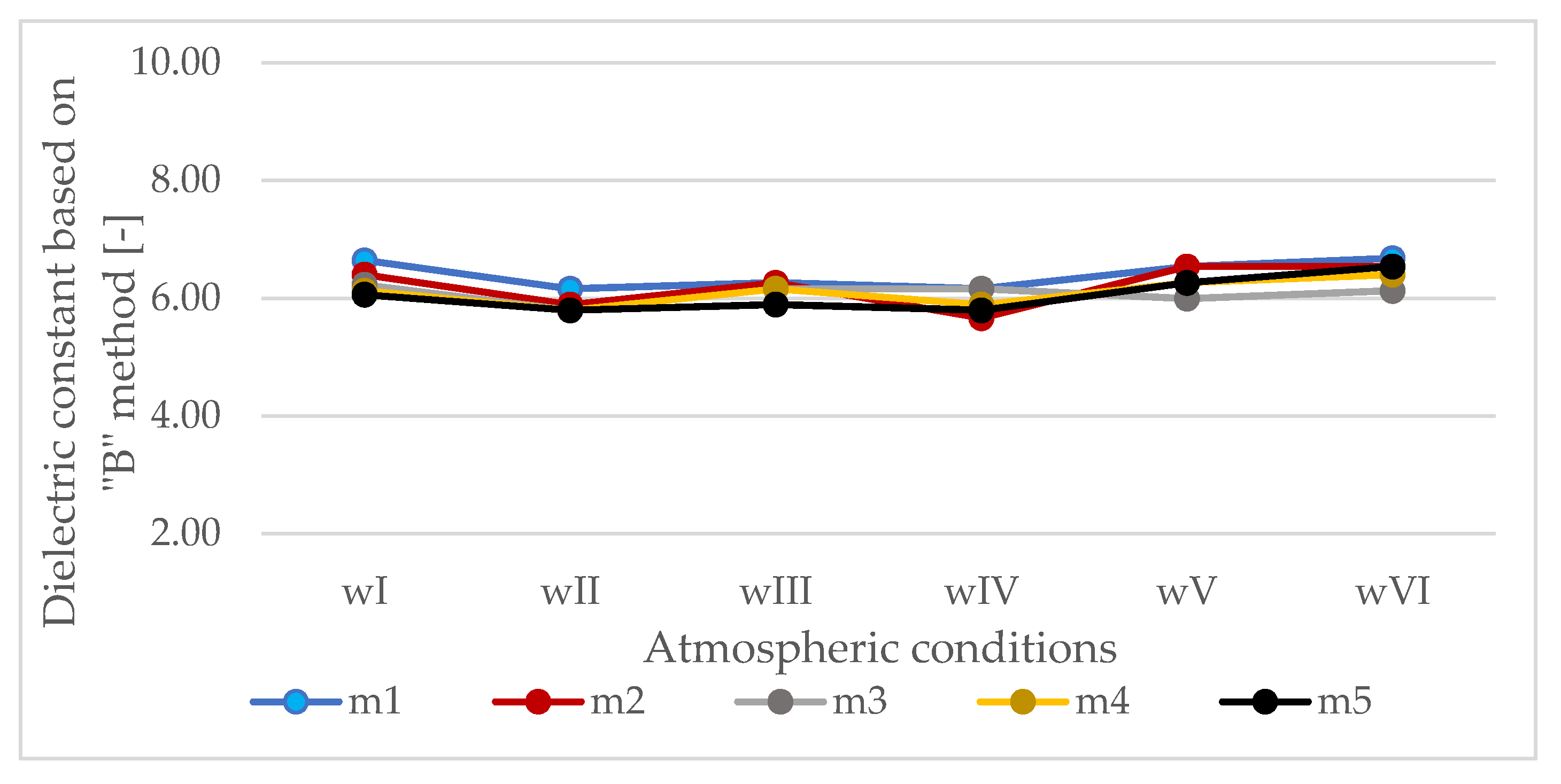
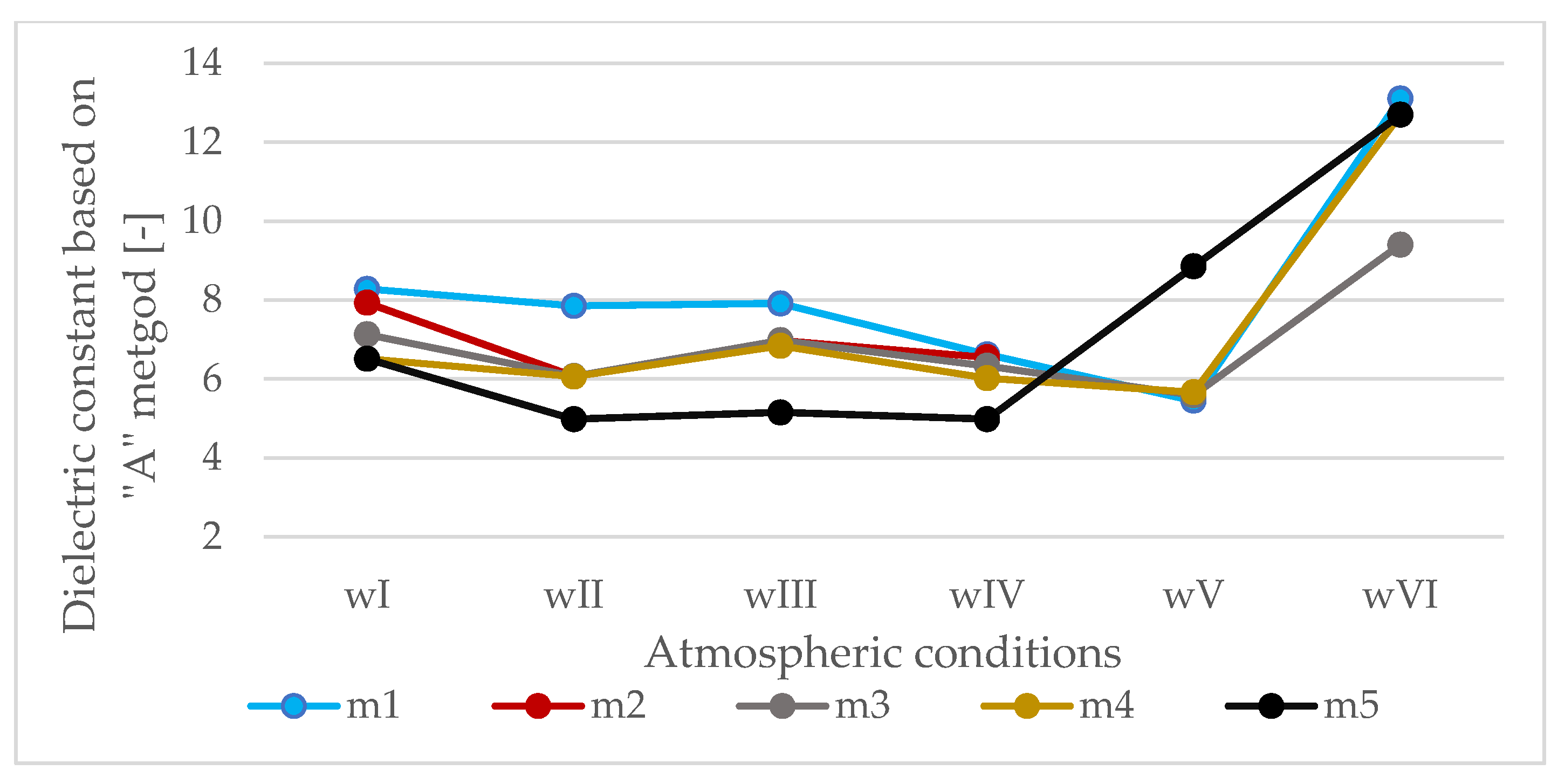
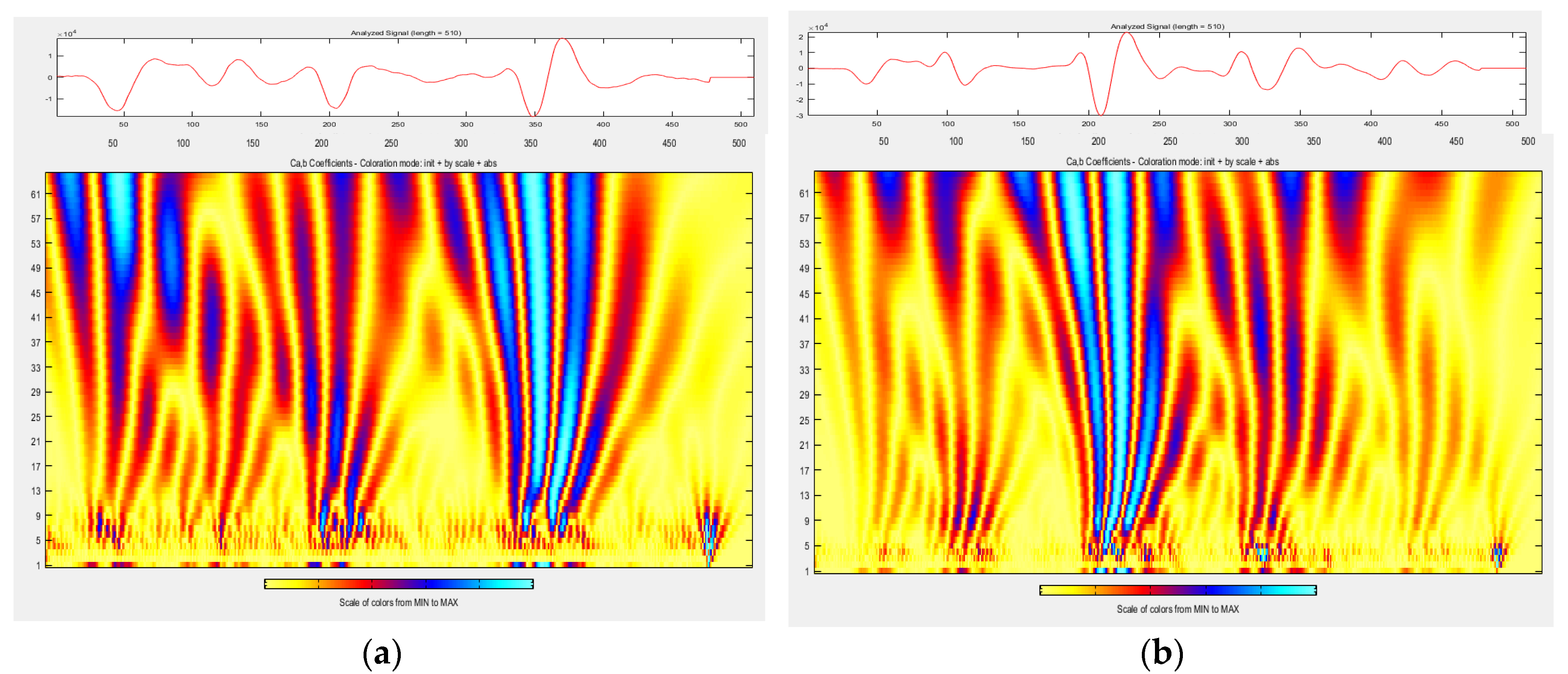
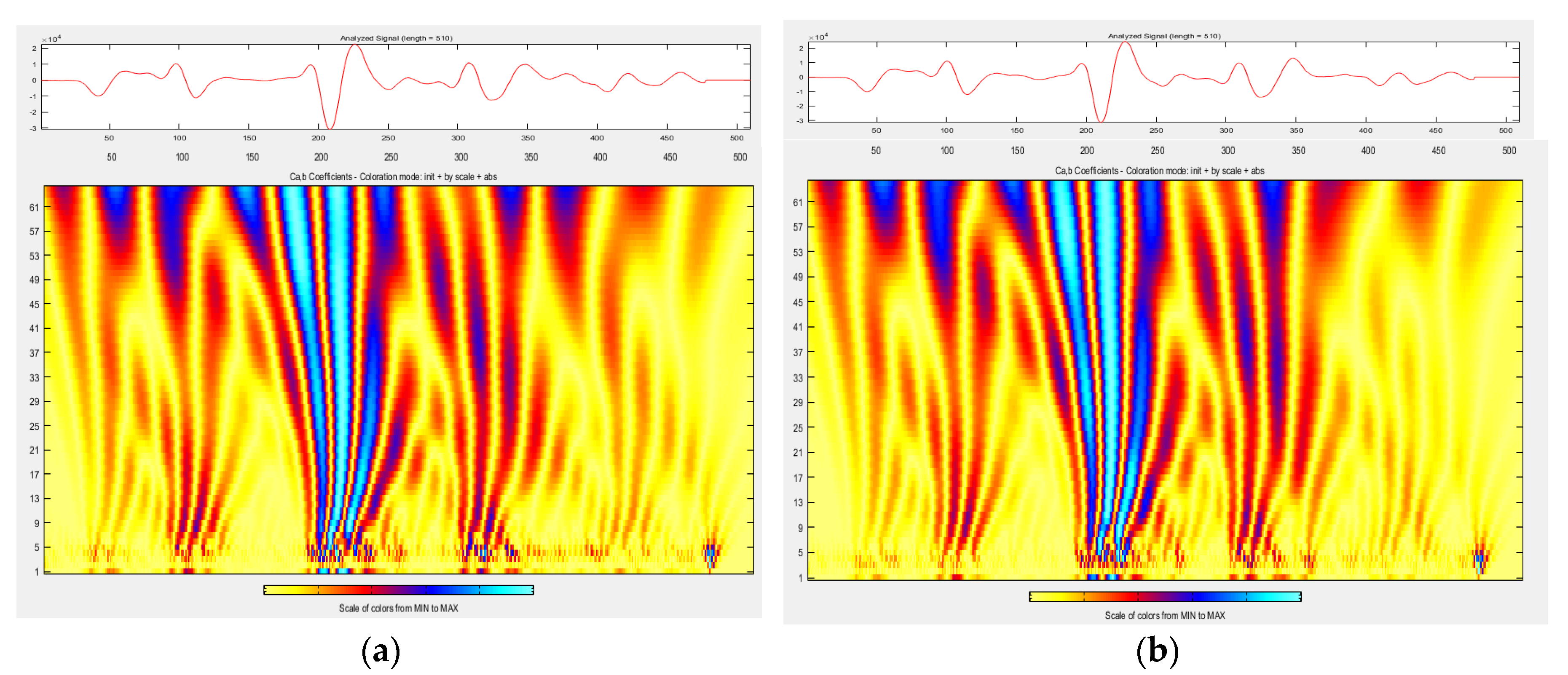
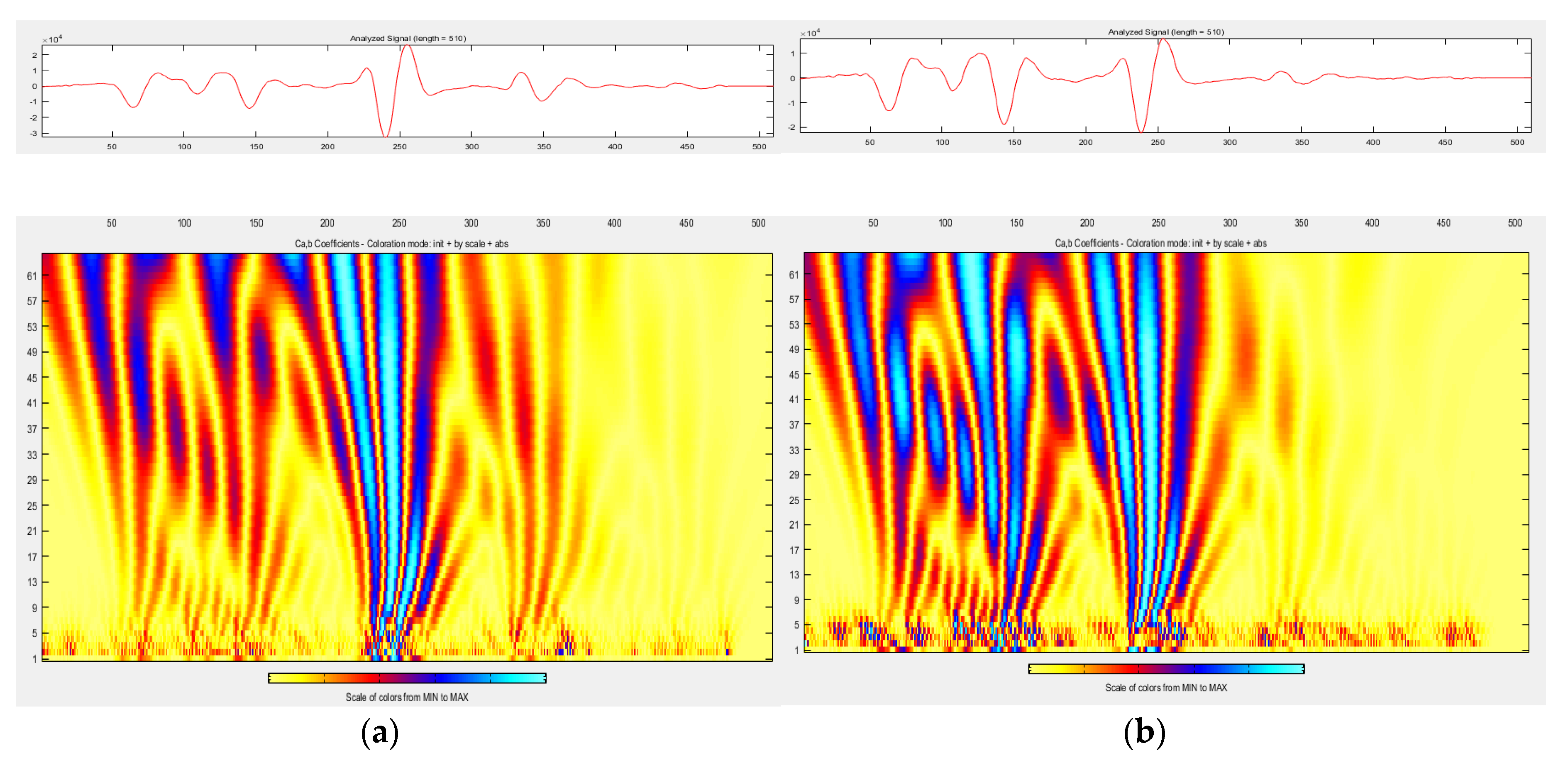
| Dielectric Constant [-] | Note |
|---|---|
| 2–4 | value given as “typical” for asphalt [18] |
| 2–4 | dry asphalt [17] |
| 6–12 | wet asphalt [17] |
| 2.5–3.5 | value given as “typical” for asphalt [21] |
| 3–6 | value given as “typical” for asphalt [22] |
| 4.0–4.9 | value determined based on SMA (stone mastic asphalt) field tests, dielectric constant calculated based on the reflected wave amplitudes [23] |
| 4–8 | value given as “typical” for asphalt [20] |
| 8–15 | slag asphalt [20] |
| 4–10 | value given as “typical” for asphalt [19] |
| Slab No. | Wearing Course (4 cm) | Bonding Layer (8 cm) | Base Layer (10 cm) |
|---|---|---|---|
| m1 | MA 8 | AC 16 W | AC 22 P |
| m2 | SMA 8 | ||
| m3 | AC 8 S | ||
| m4 | BBTM 8 | ||
| m5 | PA 8 S |
| Condition No. | Atmospheric Condition Description |
|---|---|
| wI | temperature 28 °C, dry slab surface |
| wII | temperature −5 °C, dry slab surface |
| wIII | temperature −5 °C, water film on the slab surface as a result of pouring water (about 5 L per slab) |
| wIV | temperature −5 °C, thin layer of ice on the slab surface |
| wV | temperature −2 °C, thin layer of fresh snow on the slab surface |
| wVI | temperature −2 °C, de-icing salt on the slab surface |
| t [ns] | m1 | m2 | m3 | m4 | m5 |
|---|---|---|---|---|---|
| wI | 3.78 | 3.71 | 3.66 | 3.63 | 3.61 |
| wII | 3.64 | 3.56 | 3.53 | 3.53 | 3.53 |
| wIII | 3.67 | 3.67 | 3.64 | 3.64 | 3.56 |
| wIV | 3.64 | 3.49 | 3.64 | 3.56 | 3.53 |
| wV | 3.75 | 3.75 | 3.59 | 3.67 | 3.67 |
| wVI | 3.79 | 3.75 | 3.63 | 3.71 | 3.75 |
| m1 | m2 | m3 | m4 | m5 | ||
|---|---|---|---|---|---|---|
| wI | 6.64 | 6.40 | 6.23 | 6.13 | 6.06 | 6.29 |
| wII | 6.16 | 5.89 | 5.79 | 5.79 | 5.79 | 5.88 |
| wIII | 6.26 | 6.26 | 6.16 | 6.16 | 5.89 | 6.15 |
| wIV | 6.16 | 5.66 | 6.16 | 5.89 | 5.79 | 5.93 |
| wV | 6.54 | 6.54 | 5.99 | 6.26 | 6.26 | 6.32 |
| wVI | 6.68 | 6.54 | 6.13 | 6.40 | 6.54 | 6.46 |
| m1 | m2 | m3 | m4 | m5 | |
|---|---|---|---|---|---|
| wI | 0.48 | 0.48 | 0.46 | 0.44 | 0.42 |
| wII | 0.47 | 0.45 | 0.42 | 0.42 | 0.38 |
| wIII | 0.48 | 0.45 | 0.43 | 0.45 | 0.39 |
| wIV | 0.44 | 0.44 | 0.43 | 0.42 | 0.38 |
| wV | 0.40 | gross error | 0.41 | 0.41 | 0.50 |
| wVI | 0.57 | gross error | 0.51 | 0.56 | 0.63 |
| m1 | m2 | m3 | m4 | m5 | ||
|---|---|---|---|---|---|---|
| wI | 8.28 | 7.93 | 7.13 | 6.51 | 6.51 | 7.27 |
| wII | 7.85 | 6.07 | 6.07 | 6.06 | 4.98 | 6.21 |
| wIII | 7.91 | 6.98 | 6.98 | 6.84 | 5.15 | 6.77 |
| wIV | 6.62 | 6.55 | 6.33 | 6.02 | 4.98 | 6.10 |
| wV | 5.45 | gross error | 5.59 | 5.66 | 8.85 | 6.39 |
| wVI | 13.10 | gross error | 9.40 | 12.69 | 12.69 | 11.97 |
| m1 | m2 | m3 | m4 | m5 | |
|---|---|---|---|---|---|
| wI | 19.70 | 19.76 | 20.56 | 21.34 | 21.22 |
| wII | 19.49 | 21.67 | 21.49 | 21.51 | 23.73 |
| wIII | 19.57 | 20.84 | 20.67 | 20.88 | 23.53 |
| wIV | 21.22 | 20.45 | 21.70 | 21.76 | 23.73 |
| wV | 24.09 | gross error | 22.78 | 23.14 | 18.50 |
| wVI | 15.71 | gross error | 17.76 | 15.62 | 15.79 |
| [%] | m1 | m2 | m3 | m4 | m5 | Mean of the Absolute Value |
|---|---|---|---|---|---|---|
| wI | −10 | −10 | −7 | −3 | −4 | 7 |
| wII | −11 | −1 | −2 | −2 | 8 | 5 |
| wIII | −11 | −5 | −6 | −5 | 7 | 7 |
| wIV | −4 | −7 | −1 | −1 | 8 | 4 |
| wV | 10 | gross error | 4 | 5 | −16 | 7 |
| wVI | −29 | gross error | −19 | −29 | −28 | 21 |
| m1 | m2 | m3 | m4 | m5 | ||
|---|---|---|---|---|---|---|
| wI | 0.80 | 0.81 | 0.87 | 0.94 | 0.93 | 0.87 |
| wII | 0.78 | 0.97 | 0.95 | 0.96 | 1.16 | 0.97 |
| wIII | 0.79 | 0.90 | 0.88 | 0.90 | 1.14 | 0.92 |
| wIV | 0.93 | 0.86 | 0.97 | 0.98 | 1.16 | 0.98 |
| wV | 1.20 | gross error | 1.07 | 1.11 | 0.71 | 1.02 |
| wVI | 0.51 | gross error | 0.65 | 0.50 | 0.52 | 0.55 |
| m1 | m2 | m3 | m4 | m5 | |
|---|---|---|---|---|---|
| wI | 21.1 | 21.2 | 22.0 | 22.9 | 22.7 |
| wII | 19.8 | 22.1 | 21.9 | 21.9 | 24.1 |
| wIII | 20.4 | 21.7 | 21.5 | 21.7 | 24.5 |
| wIV | 21.4 | 20.6 | 21.9 | 22.0 | 23.9 |
| wV | 23.8 | gross error | 22.5 | 22.9 | 18.3 |
| wVI | 21.3 | gross error | 24.1 | 21.2 | 21.4 |
| [%] | m1 | m2 | m3 | m4 | m5 | Mean of the Absolute Value |
|---|---|---|---|---|---|---|
| wI | −4 | −4 | 0 | 4 | 3 | 3 |
| wII | −10 | 0 | −1 | −1 | 10 | 4 |
| wIII | −7 | −1 | −2 | −1 | 11 | 5 |
| wIV | −3 | −6 | 0 | 0 | 9 | 4 |
| wV | 8 | gross error | 2 | 4 | −17 | 6 |
| wVI | −3 | gross error | 9 | −4 | −3 | 4 |
© 2020 by the authors. Licensee MDPI, Basel, Switzerland. This article is an open access article distributed under the terms and conditions of the Creative Commons Attribution (CC BY) license (http://creativecommons.org/licenses/by/4.0/).
Share and Cite
Wutke, M.; Lejzerowicz, A.; Garbacz, A. The Use of Wavelet Analysis to Improve the Accuracy of Pavement Layer Thickness Estimation Based on Amplitudes of Electromagnetic Waves. Materials 2020, 13, 3214. https://doi.org/10.3390/ma13143214
Wutke M, Lejzerowicz A, Garbacz A. The Use of Wavelet Analysis to Improve the Accuracy of Pavement Layer Thickness Estimation Based on Amplitudes of Electromagnetic Waves. Materials. 2020; 13(14):3214. https://doi.org/10.3390/ma13143214
Chicago/Turabian StyleWutke, Małgorzata, Anna Lejzerowicz, and Andrzej Garbacz. 2020. "The Use of Wavelet Analysis to Improve the Accuracy of Pavement Layer Thickness Estimation Based on Amplitudes of Electromagnetic Waves" Materials 13, no. 14: 3214. https://doi.org/10.3390/ma13143214
APA StyleWutke, M., Lejzerowicz, A., & Garbacz, A. (2020). The Use of Wavelet Analysis to Improve the Accuracy of Pavement Layer Thickness Estimation Based on Amplitudes of Electromagnetic Waves. Materials, 13(14), 3214. https://doi.org/10.3390/ma13143214






